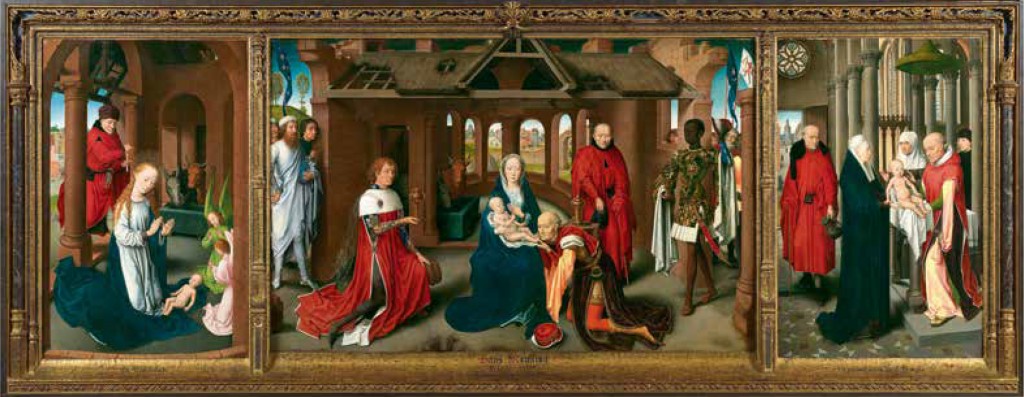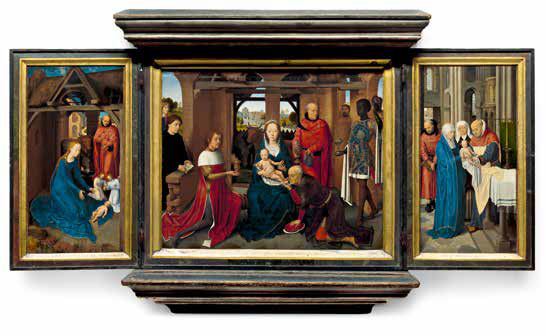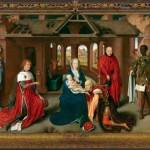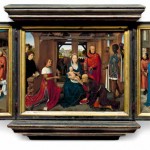Coming up for auction in April, “Nativity” is nothing short of a serendipitous discovery of Early Netherlandish panel painting. Originating from the workshop of Hans Memling, the painting is distinct from the collective style of late medieval painters’ studios and points the way for future research on the Memling workshop.
“Nativity” was first publically presented at a 1994 exhibition of Memling’s work held at the Groeningemusum in Bruges, Belgium, on the occasion of the 500th anniversary of the artist’s death. It is one of the most important recent discoveries from the late 15th century.
Preserved in surprisingly good condition, the panel is a variation on Hans Memling’s pictorial innovations to the nativity scene, in which the divine infant is placed in the ruins of a Romanesque sacral building. It takes its cue from a vision of Saint Bridget of Sweden that was highly popular in the late Middle Ages. Produced around 1500, and most definitely in Bruges, the present panel is a play on the painting by Memling, who for his part referenced his Brussels teacher Rogier van der Weyden when addressing the motif of the birth of Christ.
The earliest surviving nativity scene from Memling’s workshop can be seen on the left panel of the “Adoration of the Kings” triptych, which was finished in 1470/75 and is now kept at the Museo del Prado in Madrid. It resembles the present painting both in terms of format and subject. They are both significantly larger than the nativity scene in Memling’s 1479 “Triptych of Jan Floreins”, one of the major works in the painting collection owned by St. John’s Hospital in Bruges.
At first glance, the striking similarity between the composition of this panel and that of the two famous works by Memling would seem to suggest that “Nativity” was painted by one of his disciples, but evidence from recent technological analyses supports a different conclusion: the underdrawing, which served as a base for transferring the composition onto the ground, resembles the graphic vocabulary and highly characteristic underdrawings of Memling’s mature work. The Memling workshop typically used dry materials such as chalk to draw the contours, drapery and wide hachures, which were applied in several phases and altered repeatedly both in the underdrawing and during the actual painting process. The numerous pentimenti (traces of alterations) make Memling’s underdrawings appear chaotic and indecipherable. Even during the artist’s lifetime, they necessitated clarifying contours that accentuated the basic elements of a composition.

One characteristic of “Nativity” is the casualness and apparent spontaneity of its underdrawing, which the painter clearly based on a preliminary drawing by Memling that he had access to. It was executed in a way that comes very close to works attributed to Memling. The fact that the creator of “Nativity” was familiar with Memling’s motifs and the method applied in the master’s workshop strongly suggests that he was a close assistant. This makes “Nativity” a key work for future research on the workshop of Hans Memling.
Memling’s numerous surviving paintings – which evidence an extensive production of retables, devotional pictures and portraits – are not the only reason we believe the master to have run a successful, efficiently structured workshop with several assistants working on many commissioned works at a time. The notion of a flourishing studio is also supported by the fact that two apprentices trained at his workshop in 1480 and 1483. The hands and assistants of late medieval painters’ studios had a collective method and were incredibly skilful in imitating their master’s style in minute detail. Therefore, it is hardly ever possible to verify the hand of one particular assistant in a number of paintings from a specific workshop, and Memling’s studio is no exception to this rule.

The subtle difference between the surface designs and painting styles of “Nativity” and Memling’s works might be attributable to the fact that the master was no longer alive when the painting was produced. It is quite possible that a workshop employee finished an incomplete commission after the master had died – or it was the employee who was commissioned and wanted to be recognised for his work.
Video: Workshop of Hans Memling | Nativity | Old Master Paintings
Information: Alexander Strasoldo and Damian Brenninkmeyer, experts in Old Master Paintings
Auction, Tuesday 19th April, 5 pm
Viewing from Saturday 9th April 2016
Palais Dorotheum Vienna
View the online catalogue!
Video: Old Master Paintings Preview
















